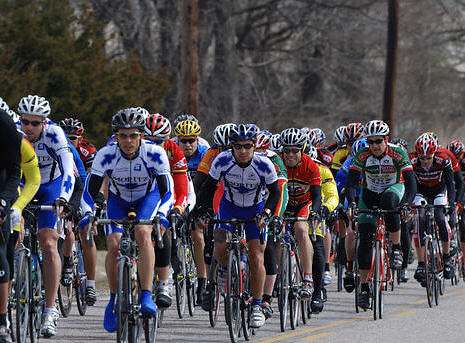 Just how fast can a Texan pedal a bike?
Just how fast can a Texan pedal a bike?
Here in Austin, home of perhaps the most powerful pair of quads in the world, plenty of bicyclists are trying to find out.
They gather for weekly hammerhead training rides that depart area coffeehouses and bike shops. They line up for a 33-week bike race series staged on a track in East Austin. They drop $3,000 to $5,000 on road racing bikes that weigh considerably less than the tricycle you had as a kid.
Austin’s warm climate, varied terrain and obsession with fitness make it a great place for budding bike racers. And yes, there’s the Lance Armstrong effect. The seven-time winner of the Tour de France is regularly spotted training on the hills around town. Talk about motivation!
‘It’s definitely the hottest scene in Texas,’ says Andrew Willis, president of the Texas Bicycle Racing Association, the governing body of bike racing in the state, and the head of Holland Racing, every Thursday from March to October.
The Driveway Series isn’t exactly the Tour de France, but it does epitomize local bike racing.
Announcers call the action as cyclists zoom past on a privately owned, twisty paved loop usually reserved for race cars and motorized go-carts. Sponsors names hang from temporary fencing. Cyclists and fans dissect the action while munching burgers grilled under a tent. Riders throw their hands high as they blow across the finish line.
‘Anybody who races bikes in Austin does the Crit Series – it’s the perfect balance of racing and community,’ says John Trujillo, 27, a local racer who competes nearly every week in the series, which started March 18.
The races at the Driveway are staged on a 2.2-mile course that is partly shaded and partly exposed. Depending on how it is configured – eight variations can be set up, and they rotate each week – the route can be completely flat or include up to 90 feet of elevation gain. Sometimes the course is technical; other times it’s almost straight.
‘Other places will have group rides, but to have mock races on a closed course where the pavement is really smooth and there are officials and responsible parties should anything go wrong, and skills clinics available – that’s really unique,’ says Kate Sherwin, 30, a former professional racer who still rides in the Driveway Series.
The weekly event draws about 300 racers and spectators from as far away as Houston, San Antonio and Dallas. The races are divided into skill-based levels from beginners to elite. (In bike racing terminology, categories range from category 5 for entry-level riders to category 1, the top level in amateur racing.) There’s even a Kids Fun Lap, a special master’s series in June and July, and Ladies Night once a month hosted by the Austin Flyers cycling club.
For several years, Austin also hosted a downtown bike criterium, staged on urban roads around City Hall. Because of a lack of sponsors this year, that race has been canceled.
But bike racing isn’t for folks with light wallets.
Nearly 90 percent of bike racers are men, between the ages of 35 and 45 years old, with a healthy amount of disposable income. According to the National Association of Sporting Goods, the average household income of a bike racer is $75,000. The average racing bike costs about $3,500, but that number can easily climb to $5,000 or more. In Texas, 30 percent of racers earn between $100,000 and $150,000, and about half have bachelor’s degrees, according to a 2007 survey by Racing Post, a Dallas-based cycling magazine.
According to USA Cycling, the governing body of bike racing in the United States, Texas trails only California in the number of licensed bike racers.
The fastest-growing segment of racers is 50-years-and-older males who have retired from impact sports like running and triathlon. Cycling isn’t as hard on the knees.
But it is fierce, which might partly explain why it’s more popular among men than women.
‘Racing is really competitive, it’s ego-driven, and it doesn’t have the feel of a multi-sport event. People show up, they race, they check results and go home,’ Willis says.
Willis, a former professional racer himself, is now more involved in the business side of the sport. Last year he took over the Driveway Series from Barry Lee, who had started it in 2006.
‘It’s an incredibly rewarding sport,’ Willis says. ‘It forces you to stay focused, set goals and work toward them in a way just (recreational) cycling doesn’t.’
By Pamela LeBlanc of austin360.com – Link to Original Article here


 Tour de Cypress Ride
Tour de Cypress Ride